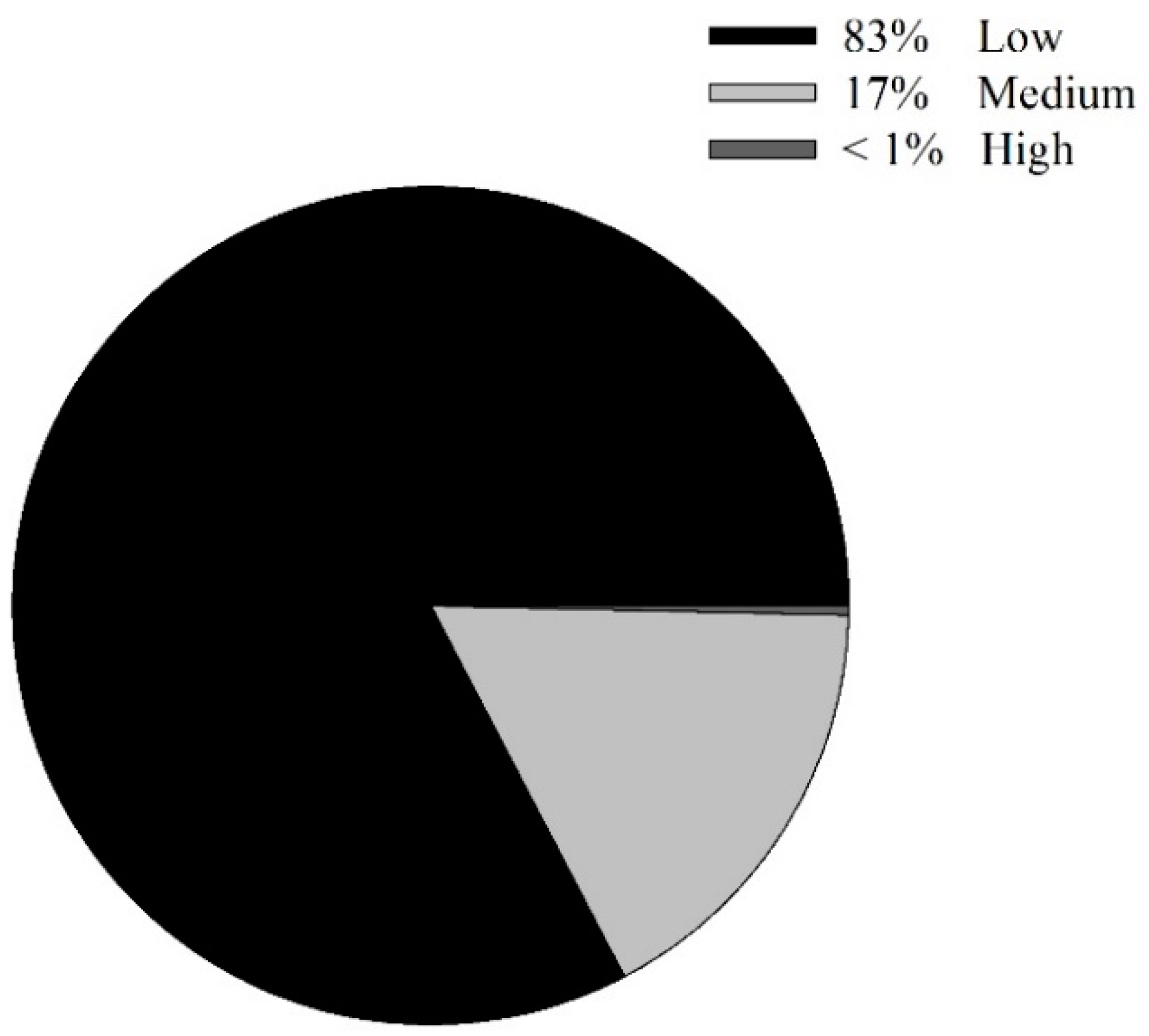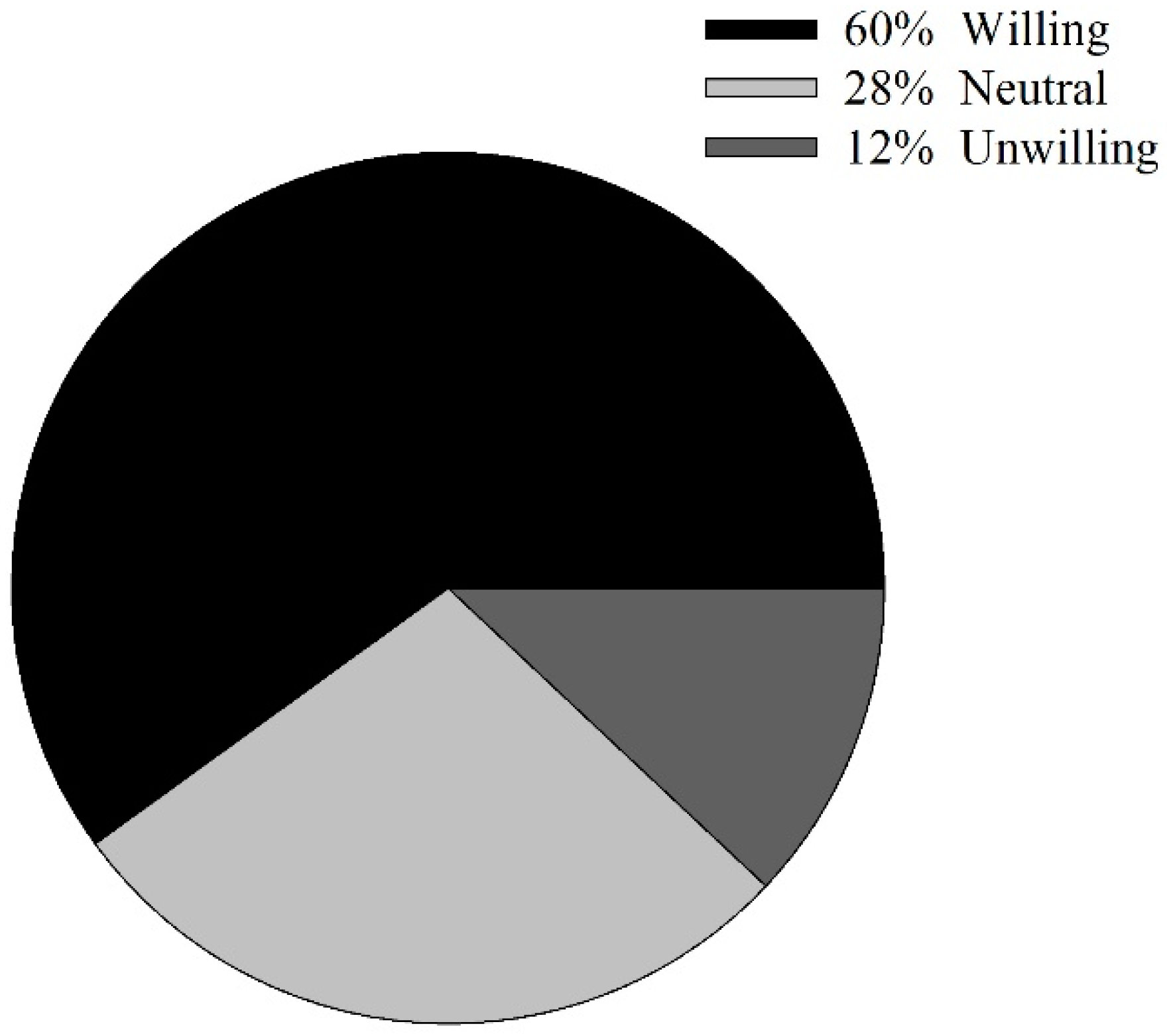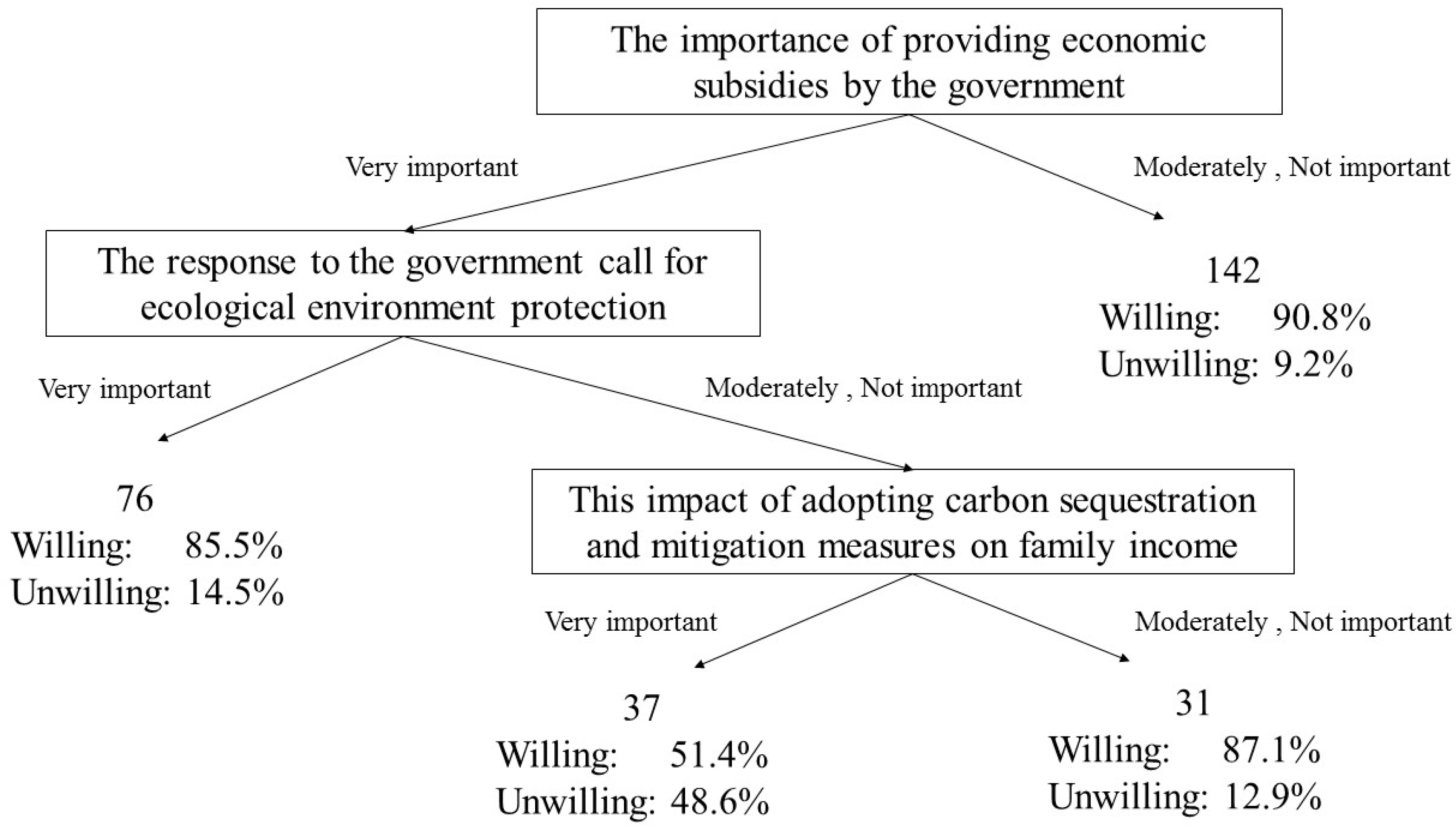How Willing Are Herders to Participate in Carbon Sequestration and Mitigation? An Inner Mongolian Grassland Case
Abstract
:1. Introduction
2. Literature Review
3. Materials and Methods
3.1. Study Area
3.2. Herdsman Survey
3.3. Data Analysis
3.3.1. Evaluation of Herders’ Cognition on Grassland Carbon Sequestration and Mitigation
3.3.2. Analysis on the Willingness of Herdsman Households to Participate in Grassland Carbon Sequestration and Mitigation and the Corresponding Influencing Factors
4. Results
4.1. Cognition on Grassland Carbon Sequestration and Mitigation by Herdsman Households
4.2. Herders’ Willing to Participate in Grassland Carbon Sequestration and Mitigation and the Corresponding Influencing Factors
4.3. The Decision-Making Process of Herdsman Households to Participate in Carbon Sequestration and Mitigation
5. Discussion
6. Conclusions
Author Contributions
Funding
Acknowledgments
Conflicts of Interest
References
- Sapkota, T.B.; Shankar, V.; Rai, M.; Jat, M.L.; Stirling, C.M.; Singh, L.K.; Jat, H.S.; Grewal, M.S. Reducing global warming potential through sustainable intensification of basmati rice-wheat systems in India. Sustainability 2017, 9, 1044. [Google Scholar] [CrossRef]
- Kosaka, Y.; Xie, S.-P. Recent global-warming hiatus tied to equatorial pacific surface cooling. Nature 2013, 501, 403–407. [Google Scholar] [CrossRef] [PubMed]
- IPCC. The Physical Science Basis. Contribution of Working Group I to the Fifth Assessment Report; Intergovernmental Panel on Climate Change: Geneva, Switzerland, 2013. [Google Scholar]
- Abonyi, A.; Acs, E.; Hidas, A.; Grigorszky, I.; Varbiro, G.; Borics, G.; Kiss, K.T. Functional diversity of phytoplankton highlights long-term gradual regime shift in the middle section of the danube river due to global warming, human impacts and oligotrophication. Freshw. Biol. 2018, 63, 456–472. [Google Scholar] [CrossRef]
- Cook, J.; Oreskes, N.; Doran, P.T.; Anderegg, W.R.L.; Verheggen, B.; Maibach, E.W.; Carlton, J.S.; Lewandowsky, S.; Skuce, A.G.; Green, S.A.; et al. Consensus on consensus: A synthesis of consensus estimates on human-caused global warming. Environ. Res. Lett. 2016, 11, 4. [Google Scholar] [CrossRef]
- Cameron, D.R.; Marvin, D.C.; Remucal, J.M.; Passero, M.C. Ecosystem management and land conservation can substantially contribute to California’s climate mitigation goals. Proc. Natl. Acad. Sci. USA 2017, 114, 12833–12838. [Google Scholar] [CrossRef] [PubMed] [Green Version]
- Hudiburg, T.; Law, B.; Turner, D.P.; Campbell, J.; Donato, D.C.; Duane, M. Carbon dynamics of oregon and northern california forests and potential land-based carbon storage. Ecol. Appl. 2009, 19, 163–180. [Google Scholar] [CrossRef] [PubMed]
- Cook, S.L.; Ma, Z. The interconnectedness between landowner knowledge, value, belief, attitude, and willingness to act: Policy implications for carbon sequestration on private rangelands. J. Environ. Manag. 2014, 134, 90–99. [Google Scholar] [CrossRef] [PubMed]
- Brogaard, S.; Zhao, X.Y. Rural reforms and changes in land management and attitudes: A case study from Inner Mongolia, China. Ambio 2002, 31, 219–225. [Google Scholar] [CrossRef] [PubMed]
- Junquera, B.; Del Brio, J.A.; Muniz, M. Citizens’ attitude to reuse of municipal solid waste: A practical application. Resour. Conserv. Recycl. 2001, 33, 51–60. [Google Scholar] [CrossRef]
- Chen, Y.; Shang, J. Estimation and effecting factor decomposition of green house gas emission of animal husbandry industry in four pastoral areas. China Popul. Resour. Environ. 2014, 24, 89–95. (In Chinese) [Google Scholar]
- Zhang, Q.; Ding, Y.; Ma, W.; Kang, S.; Li, X.; Niu, J.; Hou, X.; Li, X.; Sarula. Grazing primarily drives the relative abundance change of C-4 plants in the typical steppe grasslands across households at a regional scale. Rangel. J. 2014, 36, 565–572. [Google Scholar]
- Wu, X.; Kang, X.M.; Liu, W.J.; Cui, X.Y.; Hao, Y.B.; Wang, Y.F. Using the dndc model to simulate the potential of carbon budget in the meadow and desert steppes in Inner Mongolia, China. J. Soils Sediments 2018, 18, 63–75. [Google Scholar] [CrossRef]
- Ma, S.; Swinton, S.M.; Lupi, F.; Jolejole-Foreman, C. Farmers’ willingness to participate in payment-for-environmental-services programmes. J. Agric. Econ. 2012, 63, 604–626. [Google Scholar] [CrossRef]
- Soderqvist, T. Are farmers prosocial? Determinants of the willingness to participate in a Swedish catchment-based wetland creation programme. Ecol. Econ. 2003, 47, 105–120. [Google Scholar] [CrossRef]
- Defrancesco, E.; Gatto, P.; Runge, F.; Trestini, S. Factors affecting farmers’ participation in agri-environmental measures: A northern Italian perspective. J. Agric. Econ. 2008, 59, 114–131. [Google Scholar] [CrossRef]
- Lastra-Bravo, X.B.; Hubbard, C.; Garrod, G.; Tolon-Becerra, A. What drives farmers’ participation in eu agri-environmental schemes? Results from a qualitative meta-analysis. Environ. Sci. Policy 2015, 54, 1–9. [Google Scholar] [CrossRef]
- Li, Q.; Long, R.; Chen, H. Empirical study of the willingness of consumers to purchase low-carbon products by considering carbon labels: A case study. J. Clean. Product. 2017, 161, 1237–1250. [Google Scholar] [CrossRef]
- Khanal, P.N.; Grebner, D.L.; Munn, I.A.; Grado, S.C.; Grala, R.K.; Henderson, J.E. Evaluating non-industrial private forest landowner willingness to manage for forest carbon sequestration in the Southern United States. For. Policy Econ. 2017, 75, 112–119. [Google Scholar] [CrossRef]
- Mostafa, M.M. Egyptian consumers’ willingness to pay for carbon-labeled products: A contingent valuation analysis of socio-economic factors. J. Clean. Product. 2016, 135, 821–828. [Google Scholar] [CrossRef]
- Kong, F.; Xiong, K.; Zhang, N. Determinants of farmers’ willingness to pay and its level for ecological compensation of Poyang lake wetland, china: A household-level survey. Sustainability 2014, 6, 6714–6728. [Google Scholar] [CrossRef]
- Zhu, H.; Guan, Z.; Wei, X. Factors influencing farmers’ willingness to participate in wetland restoration: Evidence from china. Sustainability 2016, 8, 1325. [Google Scholar] [CrossRef]
- Hong, M.; Hu, C.; Gu, L.; Zhang, X.; Bao, J. Households’ willingness in participating forest management of carbon sequestration trading and the related influencing factors under the Redd+. J. Zhejiang Agric. For. Univ. 2017, 34, 207–214. (In Chinese) [Google Scholar]
- Tolunay, A.; Bassullu, C. Willingness to pay for carbon sequestration and co-benefits of forests in Turkey. Sustainability 2015, 7, 3311–3337. [Google Scholar] [CrossRef]
- Lal, R.; Follett, F.; Stewart, B.A.; Kimble, J.M. Soil carbon sequestration to mitigate climate change and advance food security. Soil Sci. 2007, 172, 943–956. [Google Scholar] [CrossRef]
- Xilinhot Bureau of Statistics. Statistical Yearbook of Xilinhot City; Xilinhot Bureau of Statistics: Xilinhot, China, 2016.
- Vanslembrouck, I.; Van Huylenbroeck, G.; Verbeke, W. Determinants of the willingness of Belgian farmers to participate in agri-environmental measures. J. Agric. Econ. 2002, 53, 489–511. [Google Scholar] [CrossRef]
- Zhang, M.A.; Borjigin, E.; Zhang, H. Mongolian nomadic culture and ecological culture: On the ecological reconstruction in the agro-pastoral mosaic zone in northern china. Ecol. Econ. 2007, 62, 19–26. [Google Scholar] [CrossRef]
- Ritten, J.P.; Bastian, C.T.; Rashford, B.S. Profitability of carbon sequestration in western rangelands of the United States. Rangel. Ecol. Manag. 2012, 65, 340–350. [Google Scholar] [CrossRef]
- Conant, R.T.; Paustian, K.; Elliott, E.T. Grassland management and conversion into grassland: Effects on soil carbon. Ecol. Appl. 2001, 11, 343–355. [Google Scholar] [CrossRef]




| Question | Evaluation Standard |
|---|---|
| Do you know that temperature rise is mainly a result of the increase in carbon dioxide concentration? | Low Medium High |
| Do you know that grasslands can absorb carbon dioxide? | |
| Do you know that carbon can be sold for money (carbon trading)? | |
| Do you understand carbon sequestration and mitigation policies? |
| Variable Type | Variable Subtype | Variable Name | Variable Meaning |
|---|---|---|---|
| Response variable | The willingness to adopt carbon sequestration and mitigation measures under the existing conditions (Y) | 0 = willing 1 = unwilling | |
| Influencing variable | Benefit factor | The impact of adopting carbon sequestration and mitigation measures on family income (X1) | very important = 1 moderately important = 2 not important = 3 |
| The effect on grassland ecological protection (X2) | very important = 1 moderately important = 2 not important = 3 | ||
| The response to the government call for ecological environment protection (X3) | very important = 1 moderately important = 2 not important = 3 | ||
| Cost factor | The importance of providing economic subsidies by the government (X4) | very important = 1 moderately important = 2 not important = 3 | |
| Corresponding trainings and guidance on taking carbon sequestration and mitigation measures (X5) | very important = 1 moderately important = 2 not important = 3 | ||
| The number of family members engaged in pasturing occupations (X6) | specific number | ||
| Other factors | The cognitive level of carbon sink and carbon sequestration and mitigation on grasslands (X7) | The numbers of “Low” question | |
| The adoption of carbon sequestration and mitigation measures by the surrounding people (X8) | very important = 1 moderately important = 2 not important = 3 |
| Explanatory Variable | Regression Coefficient | Standard Error | p |
|---|---|---|---|
| The importance of the impact on family income | −1.262 ** | 0.441 | 0.005 |
| The protection effect on grassland ecological environment | 0.557 | 0.326 | 0.094 |
| The response to the government call for ecological environment protection | 1.01 ** | 0.332 | 0.003 |
| The importance of providing economic subsidies by the government | −1.219 ** | 0.322 | 0.000 |
| The corresponding trainings and guidance for carbon sequestration and mitigation measures | 0.357 | 0.331 | 0.298 |
| The number of family members engaged in pasturing occupations | 0.094 | 0.344 | 0.604 |
| The cognitive level of carbon sink and carbon sequestration and mitigation in grassland | −0.211 | 0.399 | 0.18 |
| The adoption of carbon sequestration and mitigation measures by the surrounding people | −0.27 | 0.208 | 0.224 |
| Constant | −0.619 | 1.166 | 0.595 |
© 2018 by the authors. Licensee MDPI, Basel, Switzerland. This article is an open access article distributed under the terms and conditions of the Creative Commons Attribution (CC BY) license (http://creativecommons.org/licenses/by/4.0/).
Share and Cite
Zhao, Y.; Yan, Y.; Liu, Q.; Li, F.Y. How Willing Are Herders to Participate in Carbon Sequestration and Mitigation? An Inner Mongolian Grassland Case. Sustainability 2018, 10, 2808. https://doi.org/10.3390/su10082808
Zhao Y, Yan Y, Liu Q, Li FY. How Willing Are Herders to Participate in Carbon Sequestration and Mitigation? An Inner Mongolian Grassland Case. Sustainability. 2018; 10(8):2808. https://doi.org/10.3390/su10082808
Chicago/Turabian StyleZhao, Yanyun, Yongzhi Yan, Qingfu Liu, and Frank Yonghong Li. 2018. "How Willing Are Herders to Participate in Carbon Sequestration and Mitigation? An Inner Mongolian Grassland Case" Sustainability 10, no. 8: 2808. https://doi.org/10.3390/su10082808





